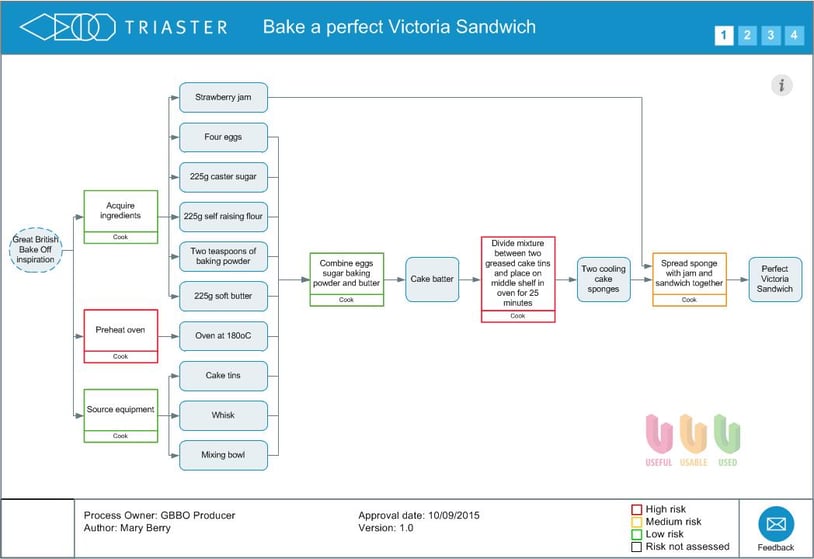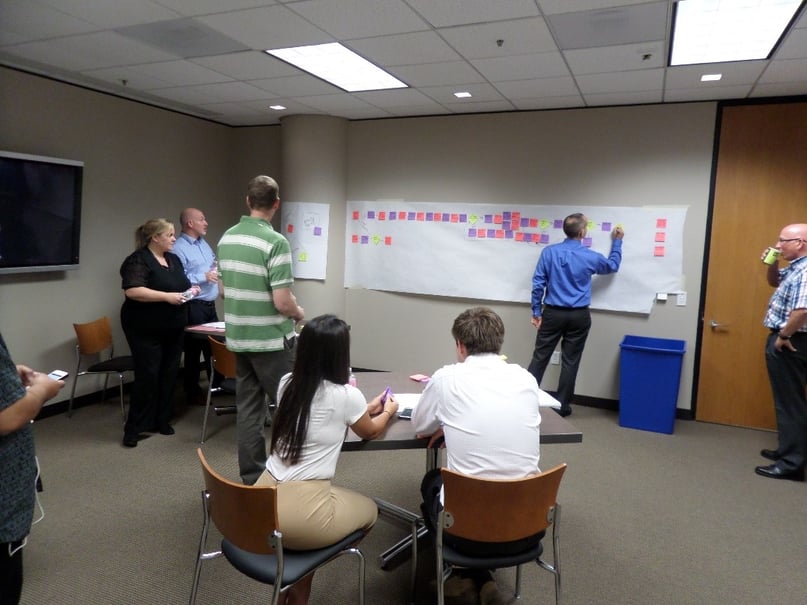A common definition of a process is, ‘a series of actions taken to achieve a particular end’. Whilst true, this doesn’t really help to explain why understanding your processes is so important and indeed why we should all care. Read on for an answer…
This article covers:
- What is a Process?
- The Benefits of Process Thinking
- How To Capture Business Processes
- Getting Everyone to Follow The Process
What is a Process?
So, a process is a series of actions taken to achieve a particular end. In other words, it’s what we do in order to achieve something.
Another way of defining a process is that it transforms inputs into outputs. This is most easily understood when thinking about the processing of physical goods, when a process is the mechanism by which raw materials are converted into products.
For example, baking a cake will involve taking various ingredients (the inputs) and producing a cake (the output) using the recipe (the process).

Manufacturing is often thought of in process terms, indeed many business process management and improvement methodologies were first developed by the manufacturing industry – where the inputs and outputs are easy to spot and the steps to transform them are generally thought of as processing.
When it comes to what many of us do for a living - sit in front of a computer all day - it’s often much harder to think of our work in terms of inputs and outputs. However, if we do there are multiple benefits to be had.
The Benefits of Process Thinking

Thinking of writing a blog article as a process means that I can be more efficient each time I write one, and also capture the actions I go through to share with colleagues, so that we all take a consistent approach.
It’s very likely that having done so a colleague will suggest some improvements to my way of working and then we will agree a best practice approach. This will be particularly helpful when new members of staff join the team.
So, the headline benefits of process thinking are:
- To embed repeatable working
- To ensure consistency of working
- To agree best practice ways of working
- To support staff training
There are others and I will explore them in other articles, but I hope that these explain why we should all care what a process is.
How To Capture Business Processes
Now that you are convinced of the benefits of process thinking, what’s the next step?
The answer to this really depends.
The traditional first step is process mapping and that absolutely delivers massive benefits. Triaster offers free Process Mapping software and this article explains both how to download it and how to use it: How To Process Map For Free with Process Navigator
However, if you work for a very small organisation you probably haven’t got the bandwidth to do this and in fact you probably don’t need to. A small team can usually capture and agree their best practice working via some post-its and a few lively conversations - and then be very agile about making improvements as they go along.

Getting Everyone to Follow The Process
The key thing is to get everyone to follow the business processes that you have agreed as best practice.
This is problematic whether you work for a very large organisation who already has their processes all mapped out and shared via a great BMS (business management system), or if this is the first time that you have thought about what you do as a process.
The solution is to make following the process easier than not doing so.
There are various ways of doing this, but the absolute best way is to implement a process execution platform like Ask The Crowd
With Ask The Crowd your best practice processes are set as lifecycles which take the responsible person step-by-step through the process - so they have to work to the agreed best practice.

Those working for large organisations can work from their process maps to transform their best practice business processes to lifecycles.
Those who work for a very small organisation can usually capture their processes directly into lifecycles in Ask the Crowd.
Both will definitely quickly see the benefits.
Sign up for a free 14 day trial to start to see the benefits for yourself.
Related Articles:
How To Process Map For Free with Process Navigator
3 Common Business Process Mapping Mistakes (and How to Avoid Them)
Capturing a Business Process: 3 Tips for Process Discovery Workshops
Related White Papers:
Written by Emma Harris
Emma was Operations Director for Triaster for nearly 20 years, during which time as well as learning and perfecting her BPM and process improvement skills, she honed her inbound marketing expertise. She now runs D2e - Designed to engage - which designs and develops bespoke, engaging, HubSpot CMS websites, that help your entire company to grow and scale. She is delighted to still be delivering Triaster's marketing, whilst also helping other companies turn their websites into their hardest working asset.


